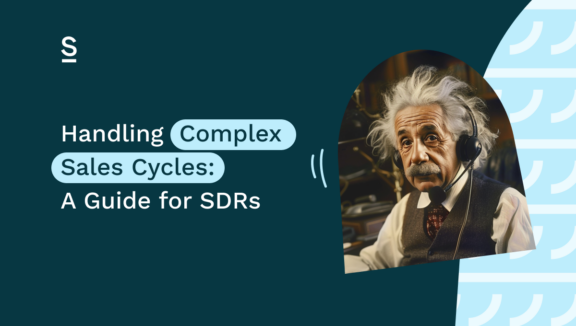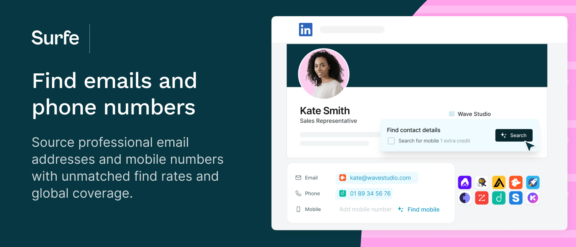Handling Complex Sales Cycles: A Guide for SDRs

In the words of Einstein: “Out of complexity find simplicity.” If only it were so simple in the world of sales!
Eye-watering quotas, frequent rejection and not enough hours in the day: there’s no question that Sales Development Representatives (SDRs) are under more pressure than ever to perform. With efficiency and revenue driving at the core of the role, it’s every SDRs dream to prospect only affirmative buyers, with large budgets and speedy approval processes.
In reality, complex sales cycles are becoming more and more common. It takes an average of seven decision-makers to sign off on B2B sales in today’s economy, and that’s just on one of your accounts. Multiply those decision-makers by your various active leads and your head starts to spin.
So, consider this article a declaration of solidarity with all of you hard-working SDRs. We know it’s difficult to balance different buyers at different stages of conversion, which is why we’ve pulled together this guide to give you some handy hints and tricks to make your life a little bit easier.
In a rush? (Of course you are, you’re an SDR!) We’ll cover:
Rapport is a Two-way Street
Building trust with your prospects is vital in your success as an SDR. Good rapport sets the foundation of the sales cycle. For your prospect, it demonstrates that you know how to address their pain points and find the right business solutions. For you, it cements the relationship in your mind as one worth committing to.
When you establish a trusting relationship with your prospect, a lot of the heavy lifting is done for you in the sales cycle. Rather than you having to chase stakeholder sign-off, an engaged prospect will have those conversations on your behalf, making the process more efficient for everyone involved. And they will be clear on their budgets so you know exactly what you are working with and which product or service to sell.
How to build rapport
You might think that building rapport comes naturally to you as someone working in sales, but there are a few easy shortcuts to cementing your position as a trusted advisor in the eyes of your prospect.
- Use active listening to really understand your prospects’ pain points: Rather than listening to respond, take the time to understand exactly what they are finding difficult with their current supplier and the challenges they face as a business or department.
- Personalize your communications: Always customize your sales outreach touches depending on which buyer segment your prospect belongs to. With Surfe, you can go even further by creating LinkedIn and InMail templates for each segment with in-built name personalization for that extra personal touch.
- Avoid salesy language: Instead of hitting a cold lead with a message like “Need a solution to drive revenue? Book a demo call now!”, try to dig around and find relevant news hooks or content pieces that indicate the prospect might be in a position to buy from you.
Lead scoring: Quality Over Quantity
You can’t prospect every lead you identify – there just wouldn’t be the time in the day. Rather than sending blanket mass emails to everyone in your CRM, you should assess the viability of your leads and work on a priority basis to which leads are most likely to convert and give you the best chance of hitting your targets. We call this process lead scoring.
Consider using the BANT or MEDDPICC frameworks to get a clearer idea of how likely your prospects are to become buyers.
BANT
Assess your leads BANT score by taking the following factors into account:
Budget
Does your prospect have sufficient financial resources to purchase your product or services?
Authority
Is your prospect the person who can make the ultimate sign-off decision to confirm a purchase?
Need
How much does your prospect need the product or service that you’re selling to solve their pain points?
Timelines
Is your prospect ready to make a purchase? Do they have any budget meetings coming up? Are they waiting on a current contract to come to a close?
With the answers to these questions, you can evaluate how likely your lead is to convert and sign on the dotted line.
MEDDPICC
MEDDPICC is another useful sales qualification framework that dives a little deeper into the needs of your customers. Find your MEDDPICC score by considering:
Metrics
What is the potential value of the prospect to your sales team?
Economic Buyer
Is the prospect the key decision-maker involved in buying your product or service?
Paper Process
What is the process the buyer needs to undertake to commit to buying from you?
Pain Points
What are the pain points of your buyer and how can your product or service solve them?
Champion
How easily can you build relationships with other internal stakeholders to advocate for your product or service?
Competition
How does your product or service compare to the buyers’ competitors?
Remember, your prospect holds the answer to all these questions. To implement either the BANT or MEDDPICC frameworks, make sure you are asking the right questions around budget, pain points and sign-off processes to understand just how viable your leads really are.
Tools and Technologies to Save You Time
How efficient is your CRM?
A well-maintained CRM can be the difference between a successful sales team and a struggling one. Without clean, up-to-date data, you can expect high bounce rates and discouraging levels of rejection.
Avoid human error
Consider integrating your CRM system with LinkedIn to ensure you’re adding the right contact details into your person records in Salesforce or HubSpot. With Surfe, you can import accurate data into your CRM in just one click, so you’ll know your sales outreach is landing in the right person’s inbox.
Make the most of data enrichment tools
Is your CRM filled with half-complete records that don’t include crucial information like job titles, industry or mobile numbers? Data enrichment tools like Lighthouse by Surfe enable you to enrich contact data at scale. And when each year 20% of your CRM data becomes outdated, it’s important you remember to clean your data and ensure all your records are as current as possible. So you’ll spend less time reaching out to prospects who have changed companies or moved into another role.
Make your life simpler while juggling multiple buyers at different stages of the sales cycle by knowing your CRM is giving you a clearer picture of your prospect profile.

Handling Objections
Objection and rejection is part and parcel of the job of an SDR. But knowing how to effectively respond when a prospect objects can be your silver bullet to sealing the deal. Budget constraints and skepticism about the product are common objections in sales. Take the time to listen to your prospect’s concerns and understand what precisely they are objecting to.
Show empathy by validating their feelings and sharing that these pain points are common among other customers. Then, clearly explain how your product or service can address their issues and help them justify the expense to their team. Be solutions-oriented, offering alternatives or facilitating meetings with decision-makers. Finally, confirm the next steps to keep the sales process moving forward.
We call this the feel, felt, found method. And it can help you to better handle any objections your prospect might come to you with:
- Feel: Acknowledge how your prospect is feeling about their pain points.
- Felt: Let your prospect know that other customers have felt the same way before. It’s a common problem and they aren’t alone in experiencing it.
- Found: Outline the solutions existing customers found useful after choosing your product or service.
Following Up and Finding Your Referrers
Top-performing SDRs know the value of a thorough follow-up strategy. Showing up consistently in the sales cycle with multiple touches across different channels will nudge your prospects further down the buying process.
Mix up your channels
No one spends their entire day exclusively in their email inbox or on LinkedIn. Work happens across multiple platforms and diverse communications channels. Use data from your social channels, email sending software and your website to determine when and where people respond best to receiving sales outreach to you. For example, if you have already called a prospect twice to no avail, think about adding them as a connection on LinkedIn to remind them of your existence. If you know that a prospect is traveling for work without internet access, consider leaving them a voicemail so they can answer at their convenience.
Timing is everything
When seeking a referral, think about the right time to ask. Customers tend to be most engaged and bought-in to your product or service just after buying from you. Capitalize on the momentum of the sale to ask for a referral or testimonial shortly after completing your deal.
Automate where possible
A staggering 80% of sales require at least five follow-ups to land the deal. That’s a lot of your precious time and energy spent chasing prospects who might not convert. Adopt automation tools like Surfe’s personalized message templates for LinkedIn and InMail to take some of the admin off your plate, and know that you’re landing your value proposition in each sales touch.
Let’s Wrap it Up!
Navigating complex sales cycles as an SDR is a tricky balance to tread. It requires a blend of strategy, empathy, and persistence to advance your prospects through the sales cycle.
Be smart in your follow-up strategies by using timely, frequent communications via calls, emails, and on social. Avoid being intrusive by asking for referrals just after a deal has closed, so you’re still fresh in the mind of your new customer. And utilize CRM tools and automation to streamline these processes, so no lead falls through the cracks.
You’ve got this, SDRs! Keep on keeping on.

Need to simplify your complex sales cycles?
Surfe’s got you covered. With personalized message templates and an unbeaten email finder, Surfe saves you time on the admin so you can get back to prospecting.
Frequently Asked Questions (FAQs)
How can I build better rapport with my prospects as an SDR?
- Build rapport with your prospects by using active listening to understand their pain points, personalizing your communications to build trust, and avoiding overly salesy language.
Why is lead scoring so important to simplify the sales cycle?
- Lead scoring helps you understand how viable your leads are so you can prioritize which prospects to focus your resources on.
What tools and technologies can I use to save time and simplify the sales cycle as an SDR?
- Chrome extensions like Surfe can help you create personalized message templates for sales outreach and follow-ups, and help you clean your CRM data to improve the quality of your contact details for outreach.


